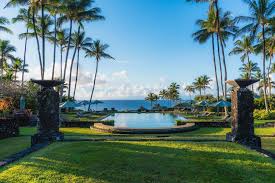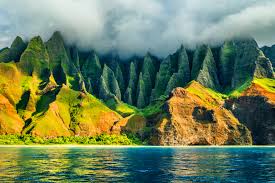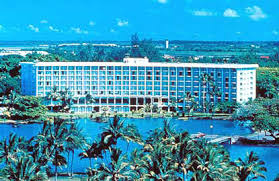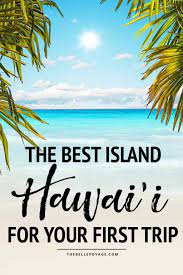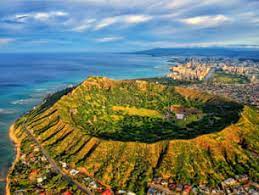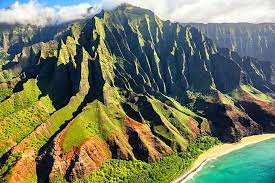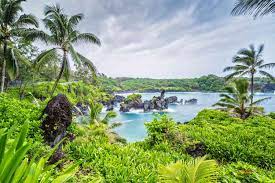
Maui, Hawaii: A Paradise of Unforgettable Tourist Attractions
Nestled in the heart of the Pacific Ocean, Maui is a tropical paradise that captivates visitors with its breathtaking landscapes, vibrant culture, and warm hospitality. Known as “The Valley Isle,” this enchanting island offers an abundance of tourist attractions that will leave you spellbound. From pristine beaches to majestic waterfalls and lush rainforests, Maui has something for everyone. Let’s explore some of the must-visit destinations on this idyllic island.
One cannot talk about Maui without mentioning its world-renowned beaches. With over 30 miles of coastline, there is a beach for every preference. Kaanapali Beach, located on the west side of the island, is a popular choice for its golden sand and crystal-clear waters. It offers excellent snorkeling opportunities and is home to several luxury resorts. If you’re seeking seclusion and tranquility, head to the hidden gem of Makena Beach or the picturesque Hamoa Beach in Hana.
Speaking of Hana, this small town on Maui’s eastern coast is a destination in itself. The Road to Hana is an iconic drive that takes you along a winding coastal road with breathtaking views at every turn. Along the way, you’ll encounter cascading waterfalls like Wailua Falls and stunning natural wonders such as the Seven Sacred Pools at Ohe’o Gulch. Hana also boasts black sand beaches like Wai’anapanapa State Park, where you can explore lava caves and witness dramatic coastal scenery.
For those seeking adventure and outdoor activities, Haleakala National Park is an absolute must-visit. This expansive park encompasses the dormant Haleakala volcano, offering visitors a chance to witness one of nature’s most awe-inspiring spectacles – the sunrise from its summit. The panoramic views from atop Haleakala are simply breathtaking and provide an unforgettable experience. Additionally, the park offers numerous hiking trails, showcasing the island’s unique flora and fauna.
Maui is also a paradise for water enthusiasts. The island’s warm waters are perfect for snorkeling and diving. Molokini Crater, located just off the coast of Maui, is a popular spot for snorkelers due to its crystal-clear visibility and vibrant marine life. If you’re feeling adventurous, embark on a whale-watching tour during the winter months when humpback whales migrate to Maui’s waters.
To immerse yourself in Hawaiian culture, visit the historic town of Lahaina. Once a bustling whaling village, Lahaina now offers a glimpse into Maui’s rich heritage. Stroll along Front Street and explore its art galleries, boutiques, and restaurants housed in charming 19th-century buildings. Don’t miss the opportunity to attend a traditional luau where you can savor delicious Hawaiian cuisine while enjoying captivating hula performances.
These are just a few highlights of what Maui has to offer. Whether you seek relaxation on pristine beaches or adventure amidst stunning natural wonders, Maui will exceed your expectations. Its beauty and allure are unmatched, leaving visitors with memories that will last a lifetime. So pack your bags and get ready to experience the magic of Maui – an island that truly embodies paradise.
Exploring the Wonders of Maui: A Guide to its Breathtaking Natural Beauty, Outdoor Adventure Opportunities, Rich Cultural Heritage, Unforgettable Road Trips, and Luxury Resorts and Hospitality
- Breathtaking Natural Beauty
- Outdoor Adventure Opportunities
- Rich Cultural Heritage
- Unforgettable Road Trips
- Luxury Resorts and Hospitality
Challenges of Maui Hawaii Tourist Attractions: Crowds, Cost, and Accessibility
- Crowds and Tourist Traffic
- Higher Cost of Living
- Limited Accessibility
Breathtaking Natural Beauty
Breathtaking Natural Beauty: Maui’s Unmatched Tourist Attractions
Maui, Hawaii, is a destination that boasts unparalleled natural beauty, making it a haven for nature enthusiasts and adventure seekers alike. The island’s tourist attractions are renowned for their awe-inspiring landscapes, captivating visitors with their breathtaking views.
One of the standout features of Maui is its stunning beaches. With their pristine sands and crystal-clear waters, these coastal gems offer a slice of paradise. Whether you prefer the lively atmosphere of Kaanapali Beach or the secluded tranquility of Makena Beach, you’ll find yourself surrounded by beauty that is simply unmatched.
But Maui’s natural wonders extend far beyond its beaches. The island is home to majestic waterfalls that cascade down lush mountainsides, creating a mesmerizing spectacle. From the iconic Wailua Falls along the Road to Hana to the hidden treasures found deep within the rainforests, these cascades are a testament to Maui’s awe-inspiring natural beauty.
Speaking of rainforests, Maui boasts an abundance of lush greenery and vibrant flora in its tropical rainforests. Explore the enchanting trails of Haleakala National Park or venture into the dense forests of Iao Valley State Park to witness nature at its finest. The vibrant colors and diverse plant life will transport you into a world unlike any other.
In addition to its beaches and rainforests, Maui offers panoramic vistas from its towering peaks. The dormant volcano Haleakala stands tall as a testament to the island’s volcanic origins. Watching the sunrise from its summit is an experience that words cannot adequately describe – it is a sight that must be witnessed firsthand.
Maui’s commitment to preserving its natural beauty shines through in its dedication to conservation efforts. Many tourist attractions on the island emphasize sustainable practices and responsible tourism, ensuring that future generations can continue to marvel at these breathtaking landscapes.
When it comes to natural beauty, few places can rival the splendor of Maui’s tourist attractions. Whether you find yourself at a stunning beach, gazing at a majestic waterfall, or exploring the lush rainforests, you’ll be immersed in a world of unparalleled natural wonders. Maui is a destination that leaves visitors in awe and reminds us of the incredible beauty that exists on our planet.
Outdoor Adventure Opportunities
Outdoor Adventure Opportunities: Maui’s Thrilling Playground
If you’re an adventure seeker, Maui is the ultimate destination to satisfy your craving for outdoor excitement. With its diverse range of activities and stunning natural landscapes, this Hawaiian paradise offers a plethora of opportunities for thrill-seekers.
Maui’s warm and inviting waters are a haven for water sports enthusiasts. Whether you’re an experienced snorkeler or a beginner looking to explore underwater wonders, the island’s vibrant coral reefs and abundant marine life will leave you in awe. Dive into the crystal-clear waters surrounding Molokini Crater, where colorful fish and graceful sea turtles await your discovery. For those seeking more adrenaline-pumping experiences, catch some waves on Maui’s world-famous surf breaks, where surfers from around the globe come to test their skills.
But Maui’s outdoor adventures don’t stop at its shores. The island boasts an extensive network of hiking trails that wind through lush rainforests, traverse volcanic landscapes, and lead to breathtaking vistas. Lace up your hiking boots and embark on the legendary Pipiwai Trail in Haleakala National Park. This enchanting trail takes you through towering bamboo forests, past majestic waterfalls, and culminates at the awe-inspiring Waimoku Falls.
For those who prefer a bird’s-eye view of Maui’s beauty, try your hand at ziplining. Soar above treetops and valleys as you zip from one platform to another, taking in panoramic views that will leave you breathless. Several zipline courses are scattered across the island, offering different levels of excitement for adventurers of all ages.
And let’s not forget about whale-watching – an unforgettable experience that awaits visitors during winter months. Witnessing humpback whales breach and play in Maui’s waters is both humbling and awe-inspiring. Join a whale-watching tour and marvel at these magnificent creatures as they put on a show like no other.
Maui’s outdoor adventure opportunities are as diverse as the island itself. Whether you’re a water lover, hiking enthusiast, or simply seeking an adrenaline rush, Maui has something for everyone. So pack your gear, embrace the spirit of adventure, and get ready to create memories that will last a lifetime in this tropical playground.
Rich Cultural Heritage
Rich Cultural Heritage: Immerse Yourself in the Spirit of Maui
Maui, Hawaii, not only boasts stunning natural beauty but also a rich cultural heritage that is deeply rooted in the spirit of the island. One of the best ways to experience this vibrant culture is by exploring the historic town of Lahaina.
Once a bustling whaling village, Lahaina now serves as a gateway to Maui’s past. As you stroll along Front Street, you’ll be transported back in time with its charming 19th-century buildings that have been beautifully preserved. These buildings now house art galleries, boutiques, and restaurants that offer a glimpse into the island’s cultural tapestry.
But it doesn’t stop there. To truly immerse yourself in Hawaiian culture, attending a traditional luau is an absolute must. These festive gatherings showcase not only delicious local cuisine but also captivating hula performances that tell stories through graceful movements and rhythmic music. From ancient chants to modern interpretations, hula is an integral part of Hawaiian culture and offers visitors a window into the island’s traditions and values.
Beyond Lahaina and luaus, Maui’s cultural attractions are scattered throughout the island. Take some time to visit local museums and historical sites that provide insights into Maui’s past. The Bailey House Museum in Wailuku offers exhibits on Hawaiian history and artifacts from ancient times to present-day. The Whalers Village Museum in Kaanapali delves into Lahaina’s whaling era, showcasing artifacts and stories from this important period in Maui’s history.
By immersing yourself in Maui’s cultural heritage, you gain a deeper understanding of its people and their connection to the land. You’ll discover that aloha spirit isn’t just a phrase; it permeates every aspect of life on the island.
So whether you’re exploring Lahaina’s historic streets or indulging in a traditional luau feast, take the time to embrace Maui’s rich cultural heritage. It’s an opportunity to connect with the island’s past, present, and future, leaving you with memories and a newfound appreciation for the spirit of aloha.
Unforgettable Road Trips
Unforgettable Road Trips: Discovering the Beauty of Maui’s Scenic Drives
When it comes to tourist attractions, Maui in Hawaii has a hidden gem that often steals the show – its breathtaking scenic drives. The island offers two iconic road trips that are truly unforgettable experiences in themselves.
The first is the famous Road to Hana, a winding coastal road that stretches along Maui’s eastern coast. This 64-mile journey takes you through a tropical paradise, where cascading waterfalls, panoramic ocean views, and lush greenery await at every turn. As you navigate the narrow roads and bridges, you’ll be greeted by stunning natural wonders like the Twin Falls and Wailua Falls. Don’t forget to stop at the enchanting Garden of Eden Arboretum and Botanical Garden, where you can immerse yourself in the island’s diverse flora.
The Road to Hana also offers opportunities for adventure. Take a dip in the Pools of Ohe’o, a series of seven freshwater pools connected by waterfalls in Haleakala National Park. Or venture off the beaten path to explore hidden beaches like Red Sand Beach or Hamoa Beach, where you can relax and soak up the sun away from the crowds.
Another must-do road trip on Maui is driving up to the summit of Haleakala volcano. The journey begins with winding roads that gradually ascend towards the majestic crater. As you climb higher, anticipation builds for what awaits at the top – a mesmerizing sunrise view that will leave you speechless. Watching as golden hues paint the sky above Haleakala’s summit is an experience unlike any other.
Aside from sunrise viewing, Haleakala National Park offers numerous hiking trails that allow you to explore its unique volcanic landscape. From Sliding Sands Trail to Pipiwai Trail leading to Waimoku Falls, there are options for all skill levels and interests.
Both road trips offer not only stunning natural beauty but also a chance to connect with the island’s rich history and culture. Along the Road to Hana, you’ll encounter small towns like Paia and Keanae, where you can sample local delicacies and interact with friendly locals. At Haleakala, learn about the significance of the volcano in Hawaiian mythology and gain a deeper understanding of the island’s geological wonders.
Maui’s scenic drives are not just about reaching a destination; they are an adventure in themselves. The Road to Hana and the drive up to Haleakala volcano offer breathtaking views, hidden treasures, and opportunities for exploration that will create lasting memories. So, buckle up, roll down your windows, and embark on a road trip that will take you through some of nature’s most awe-inspiring landscapes on the beautiful island of Maui.
Luxury Resorts and Hospitality
Luxury Resorts and Hospitality: Experience Unparalleled Comfort in Maui
When it comes to luxury accommodations, Maui sets the bar high. This tropical paradise is home to a plethora of world-class resorts that offer an unrivaled level of comfort and hospitality. From stunning beachfront properties to secluded hideaways nestled amidst lush landscapes, Maui’s luxury resorts provide the perfect setting for an unforgettable vacation.
Imagine waking up to the sound of gentle waves crashing on the shore, with breathtaking ocean views from your private balcony. Maui’s luxury resorts offer a range of accommodation options, from spacious suites to opulent villas, ensuring that every guest’s needs are met. Impeccably designed rooms adorned with elegant furnishings create an ambiance of pure relaxation and indulgence.
But it’s not just the accommodations that make these resorts special; it’s the exceptional service and warm Hawaiian hospitality that truly sets them apart. The staff at Maui’s luxury resorts go above and beyond to ensure that every guest feels pampered and well taken care of. From personalized welcomes to attentive concierge services, they strive to create a memorable experience tailored to each individual.
Indulge your senses at world-class spas where skilled therapists provide rejuvenating treatments using natural ingredients inspired by the island’s rich flora. Unwind by pristine infinity pools surrounded by lush tropical gardens or take advantage of exclusive beach access for a day filled with sun-soaked relaxation.
For those seeking culinary delights, Maui’s luxury resorts boast a diverse array of dining options. From award-winning restaurants helmed by renowned chefs to intimate beachfront eateries serving fresh seafood delicacies, there is something to satisfy every palate. Enjoy exquisite meals crafted from locally sourced ingredients while taking in panoramic views of the Pacific Ocean or savoring romantic sunset dinners on private lanais.
Beyond the lavish amenities and services, these resorts also offer a wide range of activities and experiences for guests to enjoy. From water sports like snorkeling and paddleboarding to golfing on world-class courses, there is no shortage of entertainment options. Embark on guided excursions to explore the island’s natural wonders or simply relax on pristine beaches with a refreshing drink in hand.
Maui’s luxury resorts provide an escape from the ordinary, where every detail is meticulously crafted to ensure an unforgettable stay. Whether you’re seeking a romantic getaway, a family vacation, or simply a well-deserved retreat, these accommodations offer the perfect blend of opulence and tranquility.
Indulge in the beauty of Maui while being enveloped in luxury and hospitality that will leave you feeling rejuvenated and inspired. Experience the epitome of comfort and service as you create cherished memories in this tropical paradise. Maui’s luxury resorts are waiting to welcome you with open arms and provide an experience that surpasses all expectations.
Crowds and Tourist Traffic
Crowds and Tourist Traffic: A Consideration for Maui’s Tourist Attractions
Maui, with its stunning landscapes and vibrant culture, has rightfully earned its reputation as a top vacation destination. However, it’s important to consider that popularity comes with a downside. One of the drawbacks of visiting Maui’s tourist attractions is the potential for heavy crowds and tourist traffic.
During peak travel seasons, such as holidays or summer months, Maui can experience an influx of visitors seeking to enjoy its natural beauty. This increased footfall can lead to crowded beaches, bustling landmarks, and longer queues at popular attractions. While this energy can be exciting for some travelers who enjoy the lively atmosphere, it may not suit those seeking solitude or tranquility.
The sheer number of tourists can sometimes detract from the experience, especially if you prefer a more serene environment. The idyllic beaches that grace Maui’s shores may become crowded with sun-seekers looking for their own slice of paradise. Similarly, popular landmarks like Haleakala National Park or the Road to Hana may have heavier traffic than expected.
However, there are ways to navigate around these challenges and still make the most of your visit. Consider visiting popular attractions during off-peak hours or exploring lesser-known spots that offer similar beauty but with fewer crowds. Researching alternative beach options or seeking out hidden gems can help you find your own piece of tranquility amidst the bustling tourist scene.
Additionally, planning ahead and making reservations for activities or tours can help you avoid long waits and secure your spot in advance. Being flexible with your itinerary and exploring different areas of the island can also provide a chance to escape the busiest spots and discover lesser-explored corners of Maui.
While crowds and tourist traffic are factors to be mindful of when visiting Maui’s tourist attractions, they should not deter you from experiencing all that this beautiful island has to offer. With proper planning and a willingness to explore beyond the beaten path, you can still find moments of serenity and create unforgettable memories amidst the popularity of Maui’s tourist hotspots.
Higher Cost of Living
Higher Cost of Living: A Consideration for Maui, Hawaii Tourist Attractions
Maui, Hawaii, with its stunning beauty and captivating attractions, is undoubtedly a dream destination for many travelers. However, it’s important to be aware of one potential drawback: the higher cost of living on the island. As a popular tourist hotspot, Maui tends to have higher prices for accommodations, dining, and activities compared to other parts of the United States.
When planning your trip to Maui, it’s crucial to budget accordingly and factor in the higher expenses. Accommodations can be particularly pricey, especially if you’re looking for luxury resorts or beachfront properties. It’s advisable to book well in advance and explore various options to find the best deals that suit your budget.
Dining out on the island can also be more expensive compared to mainland prices. While there are plenty of delicious local eateries and food trucks that offer affordable options, upscale restaurants and tourist-oriented establishments may come with higher price tags. Exploring local markets and grocery stores can be a great way to save money on meals by cooking some of your own food or having picnics at scenic spots.
Participating in activities and attractions on Maui can add up quickly as well. Whether it’s snorkeling tours, helicopter rides over the island, or exploring cultural sites, these experiences often come with a premium price due to the demand from tourists. Researching ahead of time and comparing prices from different providers can help you find more affordable options without compromising on quality.
While the higher cost of living in Maui may seem like a drawback, it’s important to remember that this is partly due to its popularity as a tourist destination. The island offers unparalleled natural beauty and unique experiences that make it worth considering despite the higher expenses. By planning ahead and being mindful of your budget, you can still have an enjoyable time exploring Maui without breaking the bank.
Ultimately, being aware of the higher cost of living in Maui allows you to plan and make informed decisions. With proper budgeting and a bit of research, you can ensure a memorable trip to this tropical paradise without feeling overwhelmed by the expenses. So, embrace the beauty of Maui while keeping your wallet in mind, and get ready for an unforgettable experience in this island paradise.
Limited Accessibility
Limited Accessibility: A Consideration for Maui’s Natural Wonders
Maui, Hawaii, is renowned for its stunning natural wonders and attractions that draw visitors from around the world. However, it is important to note that some of these attractions may have limited accessibility. While the island offers a plethora of breathtaking locations, reaching certain secluded beaches or hiking trails might require additional effort or logistical planning.
One aspect to consider is the accessibility of certain beaches. While Maui boasts numerous beautiful and easily accessible beaches, there are hidden gems that may be tucked away in more remote areas. These secluded beaches often require navigating narrow roads or enduring long journeys through winding routes. It’s essential to research and plan accordingly to ensure a safe and enjoyable experience.
Similarly, some of Maui’s most captivating hiking trails may present challenges in terms of accessibility. Exploring lush rainforests or reaching breathtaking viewpoints might involve traversing rugged terrains or steep inclines. Visitors should be prepared with appropriate footwear, supplies, and physical fitness levels to fully enjoy these trails.
However, it’s important to note that while limited accessibility can pose challenges, it also contributes to preserving the natural beauty and serenity of these locations. The seclusion and untouched nature often enhance the overall experience for those who are willing to put in the extra effort.
To make the most of your visit to Maui’s less accessible attractions, consider planning ahead and seeking local advice. Engaging with knowledgeable guides or tour operators can provide valuable insights on how to navigate these areas safely and efficiently.
Ultimately, limited accessibility should not deter travelers from exploring Maui’s natural wonders but rather serve as a reminder to plan accordingly. With proper research and preparation, visitors can still enjoy the island’s hidden treasures while ensuring their safety and comfort throughout their journey.
So embrace the adventure that awaits on Maui! Discover its secluded beaches, hike its mesmerizing trails, and immerse yourself in nature’s splendor – all while keeping in mind the importance of preparedness and respect for the island’s unique accessibility challenges.
